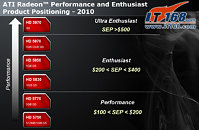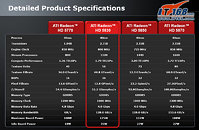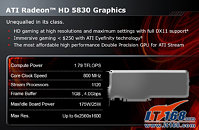- Joined
- Oct 9, 2007
- Messages
- 47,485 (7.49/day)
- Location
- Hyderabad, India
| System Name | RBMK-1000 |
|---|---|
| Processor | AMD Ryzen 7 5700G |
| Motherboard | ASUS ROG Strix B450-E Gaming |
| Cooling | DeepCool Gammax L240 V2 |
| Memory | 2x 8GB G.Skill Sniper X |
| Video Card(s) | Palit GeForce RTX 2080 SUPER GameRock |
| Storage | Western Digital Black NVMe 512GB |
| Display(s) | BenQ 1440p 60 Hz 27-inch |
| Case | Corsair Carbide 100R |
| Audio Device(s) | ASUS SupremeFX S1220A |
| Power Supply | Cooler Master MWE Gold 650W |
| Mouse | ASUS ROG Strix Impact |
| Keyboard | Gamdias Hermes E2 |
| Software | Windows 11 Pro |
AMD's new performance graphics card that targets an upper-mainstream price-point, the Radeon HD 5830, is slated for February 25. A set of company slides sourced by IT168.com shows the GPU's specifications are in tune with what we expected. The HD 5830 is based on AMD's Cypress 40 nm GPU. It has 1120 stream processors, a 256-bit wide GDDR5 memory interface, 16 ROPs, 56 TMUs, and clock speeds of 800 MHz (core) and 1000 MHz (memory). The memory bandwidth on the card is 128 GB/s, on par with that of the Radeon HD 5850. The core clock speed is slightly higher, too.
With a GPU of these specifications, AMD targets the market price-range of $200-$250, where there's room for a DirectX 11 generation graphics card to be positioned between the Radeon HD 5770 and Radeon HD 5850. The maximum board power of the card is slightly higher than that of the HD 5850, but we think that's because reference designs - if there are - might not use high-grade digital PWM circuitry. That typically shouldn't affect overclocking headroom a big deal.




The Radeon HD 5830 further has 1 GB of memory, and supports ATI Eyefinity technology. With the same display controllers as on the Radeon HD 5870, the card can support up to six physical displays. AMD's add-in board partners should be able to release non-reference design graphics cards right away, so you wouldn't have to wait any further for a PCS+, the VaporX, or the IceQ+.
View at TechPowerUp Main Site
With a GPU of these specifications, AMD targets the market price-range of $200-$250, where there's room for a DirectX 11 generation graphics card to be positioned between the Radeon HD 5770 and Radeon HD 5850. The maximum board power of the card is slightly higher than that of the HD 5850, but we think that's because reference designs - if there are - might not use high-grade digital PWM circuitry. That typically shouldn't affect overclocking headroom a big deal.




The Radeon HD 5830 further has 1 GB of memory, and supports ATI Eyefinity technology. With the same display controllers as on the Radeon HD 5870, the card can support up to six physical displays. AMD's add-in board partners should be able to release non-reference design graphics cards right away, so you wouldn't have to wait any further for a PCS+, the VaporX, or the IceQ+.
View at TechPowerUp Main Site








 erformance than the 5850
erformance than the 5850

